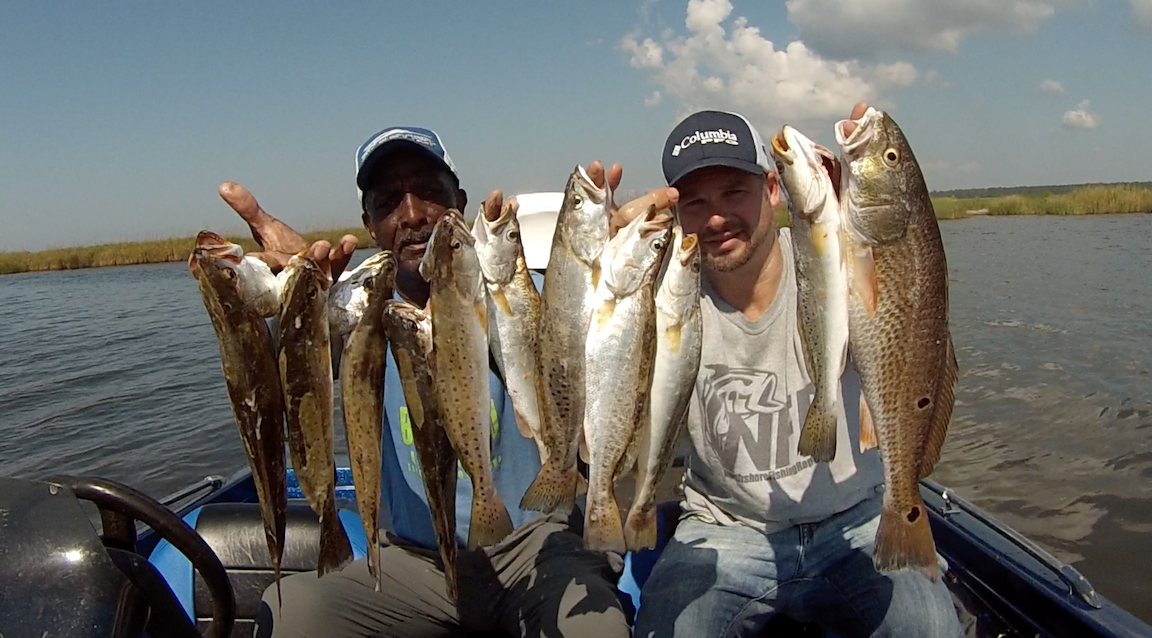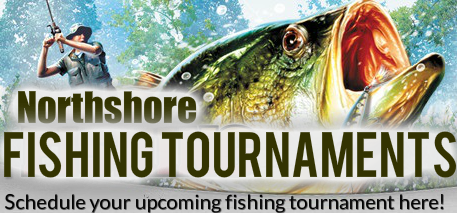 Keith Lusher
Keith Lusher With the colder temperatures that we’re seeing here on the Northshore in December, fishing can get tricky. Gone are the days of carbon copy weather forecasts of late summer as we are introduced to storm bans from the northwest, temperature swings, and barometric pressure fluctuations. Fishing in December can be a challenge but it’s important to remember to use all the factors mentioned above to you’re benefit when fishing on the North Shore of Lake Pontchartrain.
Pre-Front Storms
As we see cold fronts swing down from the mid-west they usually are accompanied by a deluge of rain. These rain storms can make fishing the rivers and bayous here on the Northshore downright tough. Rivers like the Tchefuncte and Pearl suffer the most from these rain storms. It’s important to understand that you can use the muddy water to your favor when targeting bass. The first areas that suffer from these rainstorms are the main rivers. Clarity can sometimes drop to 4” the day after a solid rain storm passes through. John Mulligan of Mandeville says he’s had numerous trips on the Tchefuncte where the water clarity was terrible and caught plenty of bass. “The muddy water never stops me!” he says. John says that it’s important to understand that while the majority of the river is muddy, there’s areas that are clean and usually that’s where the bass are. “All you have to do is find the clean water. I try and target little cuts and drains where the water coming out is clean. That’s almost always where I catch fish,” he says. John says that bass are a predator fish and will use the murky water to their benefit. “Where the clean water runs out and mixes with the muddy water you see a mixing line. What those bass do is hide in the muddy side of that line and snatch minnows that spill-out of the ditches in the clean water,” John says.
Cold Temperatures
Although we live in the south, it isn’t unusual to see daytime temperatures dip into the 40’s on some days. When fishing for bass in these temperatures it’s important to concentrate on wooden structures that protrude from beneath the water. Rivers with neighborhood canals are hotspots for December bass because they contain numerous bulkheads and pylons that soak up the suns heat and warm up the cold water beneath raising it to a temperature that is 5 degrees to 10 degrees warmer than the surrounding water. The benefits from this warmer water is twofold. One, the bass will often congregate in the warmer warmer making them easier to locate. Two, the warmer water provokes the fish to feed more aggressively. Areas like Eden Isles, Oak harbor, Coin Du Lestin, Cypress Bayou and Deloaks offer plenty of wooden structures for bass fisherman to target when the temperatures drop below the 50’s
Barometric Pressure
Barometric Pressure plays a huge role in how fish feed. Numerous studies have been performed on fish to explain why they react to pressure fluctuations that accompany cold fronts. The results show that the cause of the fish biting before the front is in direct correlation as to why they develop what most anglers describe as a case of “lock jaw” the day after the front passes. The pressure affects the fish’s bladder. After a front passes and the pressure rises, the fish’s bladder is compressed causing them to dive deeper in the water columns to escape the discomfort. During this time the last thing they are worried about is feeding. It’s because of this time, which could last more than 24-hours, that fish feed heavily before the front. They’re actually filling up to prepare for a time that they will go without food. So it’s important to the a look at the weather forecast to take advantage of these huge barometric pressure “on switches” that often happen weekly.
Pre-Front Storms
As we see cold fronts swing down from the mid-west they usually are accompanied by a deluge of rain. These rain storms can make fishing the rivers and bayous here on the Northshore downright tough. Rivers like the Tchefuncte and Pearl suffer the most from these rain storms. It’s important to understand that you can use the muddy water to your favor when targeting bass. The first areas that suffer from these rainstorms are the main rivers. Clarity can sometimes drop to 4” the day after a solid rain storm passes through. John Mulligan of Mandeville says he’s had numerous trips on the Tchefuncte where the water clarity was terrible and caught plenty of bass. “The muddy water never stops me!” he says. John says that it’s important to understand that while the majority of the river is muddy, there’s areas that are clean and usually that’s where the bass are. “All you have to do is find the clean water. I try and target little cuts and drains where the water coming out is clean. That’s almost always where I catch fish,” he says. John says that bass are a predator fish and will use the murky water to their benefit. “Where the clean water runs out and mixes with the muddy water you see a mixing line. What those bass do is hide in the muddy side of that line and snatch minnows that spill-out of the ditches in the clean water,” John says.
Cold Temperatures
Although we live in the south, it isn’t unusual to see daytime temperatures dip into the 40’s on some days. When fishing for bass in these temperatures it’s important to concentrate on wooden structures that protrude from beneath the water. Rivers with neighborhood canals are hotspots for December bass because they contain numerous bulkheads and pylons that soak up the suns heat and warm up the cold water beneath raising it to a temperature that is 5 degrees to 10 degrees warmer than the surrounding water. The benefits from this warmer water is twofold. One, the bass will often congregate in the warmer warmer making them easier to locate. Two, the warmer water provokes the fish to feed more aggressively. Areas like Eden Isles, Oak harbor, Coin Du Lestin, Cypress Bayou and Deloaks offer plenty of wooden structures for bass fisherman to target when the temperatures drop below the 50’s
Barometric Pressure
Barometric Pressure plays a huge role in how fish feed. Numerous studies have been performed on fish to explain why they react to pressure fluctuations that accompany cold fronts. The results show that the cause of the fish biting before the front is in direct correlation as to why they develop what most anglers describe as a case of “lock jaw” the day after the front passes. The pressure affects the fish’s bladder. After a front passes and the pressure rises, the fish’s bladder is compressed causing them to dive deeper in the water columns to escape the discomfort. During this time the last thing they are worried about is feeding. It’s because of this time, which could last more than 24-hours, that fish feed heavily before the front. They’re actually filling up to prepare for a time that they will go without food. So it’s important to the a look at the weather forecast to take advantage of these huge barometric pressure “on switches” that often happen weekly.

















